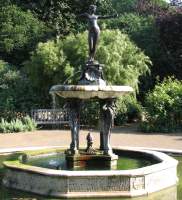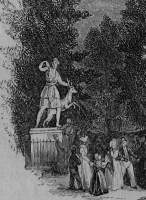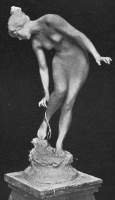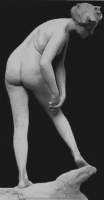 Feodora von Gleichen's Diana the Huntress.
Feodora von Gleichen's Diana the Huntress.
 Feodora von Gleichen's Diana the Huntress.
Feodora von Gleichen's Diana the Huntress.
The bronze statue of Diana the huntress in Hyde Park, also known as Artemis, stands in the flower garden at the south east corner near to Constitution arch. Diana the Huntress stands with her bow and arrow, about to shoot. She is depicted as a nude, youthful figure, small breasted but not slender, instead solid in thigh and shoulder as befits an athlete among Goddesses. Her face is classical Greek, and she wears her hair tied up to reveal her neck. She stands contrapuncto, and rotated gently and gracefully to one side. Seen from in profile and just to the rear, her pose gives an especially harmonious curve to neck, back and legs.
Diana stands in a small pond, as part of a fountain. She herself stands on a short plinth, with large shells against it, itself standing on a wide, shallow stone bowl, held aloft by three half-figure steles or half-caryatids if you like, Egyptian in style. We may note this allied work by the sculptress Feodora von Gleichen, which was produced as a fountain in Paris; the figure is rather similar in type.
Near to this apparently slightly wild but carefully cultivated garden are a variety of other statues, noted on the Hyde Park Corner page. And in Green Park across the road, though now moved a few minutes stroll away to the far corner, is the very different rendering of Diana by E. J. Clack, covered on this page.
Diana has always been a popular subject, with sculptors as much as with painters. For the sculptor, Diana is generally a dynamic, athletic female figure, wearing the lightest of drapes, or unclad. The many variants often give a nod to the Greek and Roman Dianas found in the great European museums. Some of the more modern versions have become extremely well known in their own right, for example the famous work by Houdon from the 1790s, and the iconic American one by St Gaudens in the Metropolitan Museum of Art, New York, from around 100 years later. We meet statues of Diana in literature, as in this example from Emil Zola’s His Excellency Eugene Rougon:
‘…. Clorinde was standing upon the center of a table, posing herself in the character of the huntress Diana… She was truly a superb creature with her pure perfect profile and her slender neck which so gracefully joined her shoulders. She possessed, too, the majestic beauty of an admirably moulded bust. Her rounded arms and legs gleamed like marble. Her left hip was slightly advanced and this caused her body to be somewhat curved, and her right hand being held up in the air revealed from her arm-pit to her heel a long powerful and supple line which curved inwards at her waist and then swelled outwards again at her thigh. She was resting her other hand upon her bow with all the antique huntress’s expression of serene strength, quite regardless of her nudity, and contemptuous of the love of man, cold, haughty, immortal.’
I think there should be something of these characteristics in all of our statues of Diana.
 A statue of Diana in Vauxhall.
A statue of Diana in Vauxhall.
An example of an early Diana made in England is one accompanied by her hunting dog, by Cibber, the Danish sculptor who emigrated to Britain by the 1660s. In Bushy Park, south-west London, is the Diana Fountain, attributed to Hubert le Sueur, described on this page. Above is a depiction of a later one in Vauxhall Gardens. Among the best Dianas from Victorian times and later are a Nymph of Diana by the younger George Papworth shown at the Crystal Palace, and an identically named work, by A. G. Walker dating from the 1890s, shown stooping with her ankle caught by some root or bramble; the later but also stooping Diana wounded by Bertram Mackennal; seated versions by Warrington Wood and by Mary Grant, and at least two versions from well into the 20th Century by Gilbert Bayes.
Diana figures by A. G. Walker and Bertram Mackennal.

[This page was originally part of a 'sculpture of the month' series, for December 2011. Although the older pages in that series have been absorbed within the site, if you would wish to follow the original monthly series, then jump to the Next month (January 2012) or the previous month (November 2011). To continue, go to the bottom of each page where a paragraph like this one allows you to continue to follow the monthly links.]
Go West to the Albert Memorial // East to Hyde Park Corner // East and a bit North to the Byron Statue
Visits to this page from 1 Dec 2011: 14,484